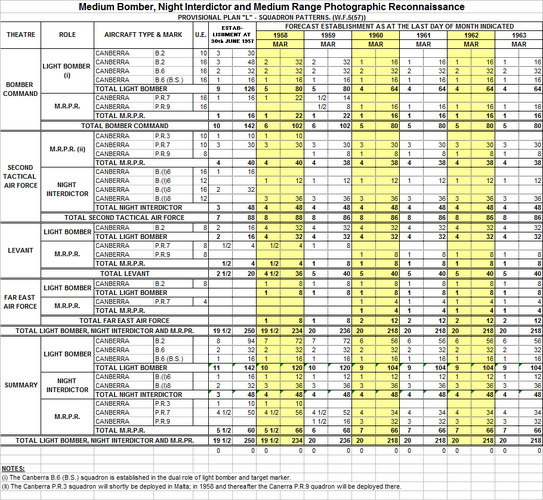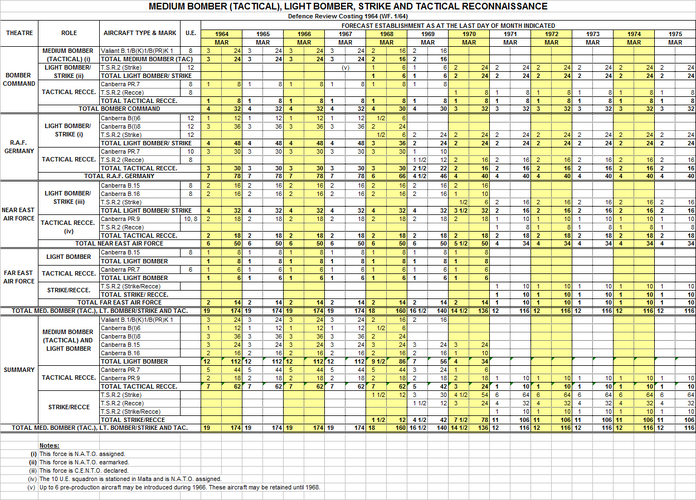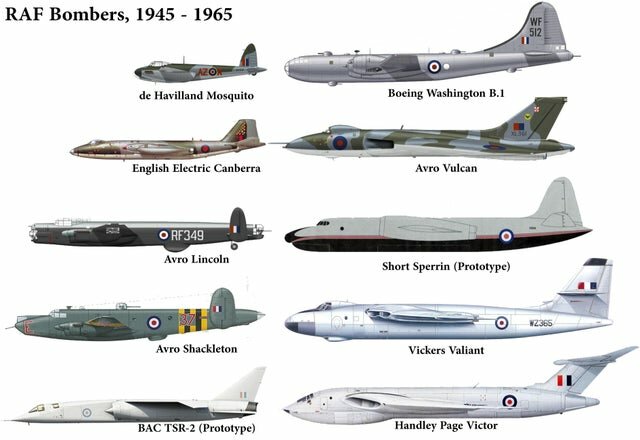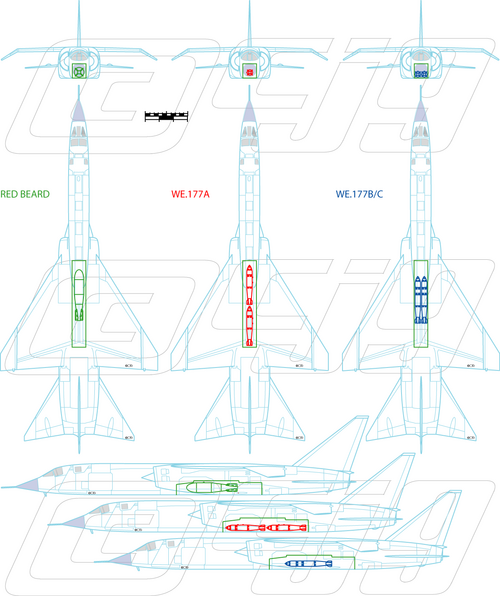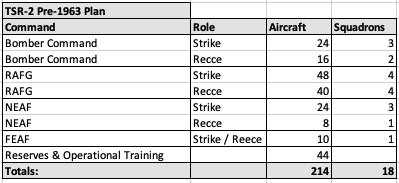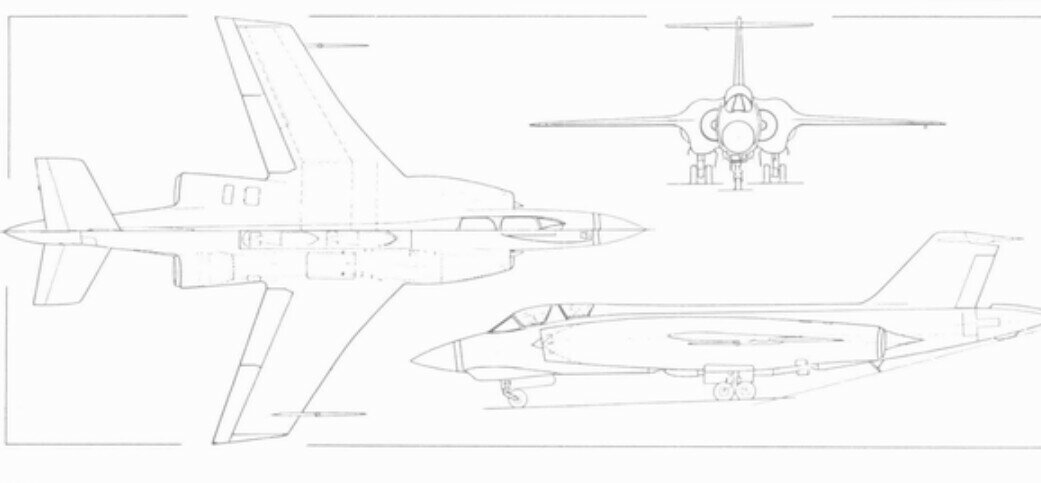In fairness to the RAF the Canberra replacement was complicated by the re-rolling of its medium bomber force.
The Valiant served in three squadrons in UK providing a theatre nuclear force for SACEUR. Canberras remained only overseas with RAF Germany and in the Near and Far East Air Forces.
Even in NEAF and FEAF Victors and Vulcans took on the serious strike role.
When TSR2 and F111 died the role of providing 50 strike aircraft for UK and NEAF/FEAF fell to the Vulcan B2.
Whereas Canberra could only carry one nuclear bomb internally, V bombers could carry two. This simple fact led to TSR2 growing in size.
Part 5 of my response.
The Situation in October 1967
The Vulcan B.2 force reached it's peak strength of 72 aircraft in nine squadrons during October 1967 when 101 Squadron converted from the Mk 1 to the Mk 2. The nine squadrons were Nos. 9, 12, 27, 35, 44, 50, 83, 101, 139 and 617. Three of these squadrons (Nos. 27, 83 and 617) were armed with Blue Steel stand-off bombs and the rest carried free-fall bombs.
However, under Plan P of March 1964 this strength should have been reached by March 1966 - 18 months earlier.
There were six squadrons of Victors in October 1967. These were:
- Nos. 101 and 139 which were medium bomber squadrons equipped with Victor B.2s carrying Blue Steel stand-off bombs.
- No. 543 equipped with the Victor SR.2s which as the aircraft's designation suggests was a strategic reconnaissance squadron.
- Nos. 55, 57 and 214 which were tanker squadrons operating the Victor Mk 1 and Mk 1A.
The 16 Victor and 72 Vulcan medium bombers in 11 squadrons carried the British strategic nuclear deterrent. According to Plan P of March 1964 it should have been maintained at this strength until March 1971.
However, this strength wasn't maintained for long because 12 Squadron disbanded on 31st December 1967 which reduced the size of the force to 80 aircraft in 10 squadrons.
1969-74
The Royal Navy's Polaris submarines relieved the the Medium Bomber Force from midnight on 30th June 1969 and according to Wynn in RAF Nuclear Deterrent Forces signified the end of an era for the RAF strategic bombing capability.
The two Victor B.2 squadrons had already disbanded. No. 100 went on 30th September 1968 and 139 ceased to be on 31st December 1968. One of the Vulcan B.2 squadrons (No. 83) disbanded on 31st August 1969.
This left 56 Vulcan B.2s in seven squadrons (Nos. 9, 27, 35, 44, 50, 101, 139 and 617) and the 8 Victor SR.2s in one squadron (No. 543).
- 16 Vulcans in two squadrons (Nos. 9 and 35) moved to Akrotiri, Cyprus in 1969 where they replaced 32 Canberra light bombers in four squadrons (Nos. 6, 32, 73 and 249).
- The 40 Vulcans in five squadrons that remained in the UK became Tactical Bombers assigned to SACEUR and restored the capability that was lost on 1st May 1965 when the three Valiant squadrons (Nos. 49, 148 and 207) disbanded. However, 27 Squadron disbanded on 29th March 1972 which reduced the UK-based Vulcan force to 32 aircraft in four squadrons.
- At some point the role of 543 Squadron changed from Strategic Reconnaissance to Maritime Radar Reconnaissance (MRR) and it became part of the Tactical Air Support to Maritime Operations (TACSMO) force. (Or the MRR role was added to its existing duties.) The squadron disbanded on 24th May 1974. It was replaced by 27 Squadron operating the Vulcan B.2 (MRR) also known as the Vulcan SR.2. No. 27 re-formed on 1st November 1973 so I'm guessing that it took six months to become operational and that's why No. 543 didn't disband until May 1974.
The Mason Defence Review of 1974-75 cut most of the remaining British forces in the Mediterranean and the two squadrons in Cyprus returned to the UK in January 1975. However, instead of disbanding they augmented the force assigned to SACEUR which increased from 32 aircraft in four squadrons to 48 aircraft in six squadrons.
1975-93
This force of six Vulcan B.2 bomber and one Vulcan B.2 (MRR) squadrons continued into the early 1980s. The seven squadrons were disbanded between December 1981 and March 1984 as follows:
- 617 Squadron disbanded on 31st December 1981
- 35 Squadron disbanded on 1st March 1982
- 27 Squadron (the MRR unit) disbanded on 31st March 1982.
- 9 Squadron disbanded on 1st May 1982.
- 101 Squadron disbanded on 4th August 1982
- 44 Squadron disbanded on 21st December 1982
- 50 Squadron's aircraft were converted to Vulcan K.2 tankers and it operated in that role from June 1982 (Source: RAFWEB) until 31st March 1984 when it disbanded. This was the last Vulcan squadron in the RAF.
Three squadrons (Nos. 9, 27 and 617) would re-form as Tornado GR.1 squadrons between June 1982 and August 1983. No. 101 would re-form as a VC.10 tanker squadron in May 1984.
Meanwhile the redundant Victor B.2s and SR.2 were converted to K.2 tankers:
- 55 Squadron operated the aircraft from June 1975 until October 1993 when it converted to the Tristar and VC10. (Source: RAFWEB) My source also says that both of these aircraft were 'borrowed' from the relevant operational units.
- 57 Squadron operated the aircraft from July 1976 until 30th June 1986 when it disbanded. (Source: RAFWEB).
- 214 Squadron continued to operate Victor K.1 and K.1A until it disbanded on 29th January 1977. The squadron was one of the victims of the Mason Defence Review of 1974-75.
According to Putnams Aircraft of the Royal Air Force since 1918 by Peter Lewis (Eighth Edition, 1988) the Mason Review also cut the number of Victor Mk 2 tanker conversions from 29 to 24.
The Buccaneer in RAF Service
The 48 Canberra interdictors in three squadrons (Nos. 3, 14 and 16) in RAF Germany disbanded between June 1970 and June 1972.
- No. 14 disbanded at Wildenrath on 30th June 1970, but re-formed the next day (1st July 1970) at Bruggen as a Phantom ground attack squadron.
- No. 3 disbanded at Laarbruch on 31st December 1971, but re-formed the next day (1st January 1972) at Wildenrath as a Harrier ground attack squadron.
- No. 16 disbanded at Laarbruch on 30th June 1972, but was re-formed as a Buccaneer squadron later in the year. See below.
They were replaced by two squadrons of Buccaneers:
- No. 15 which re-formed at RAF Honington on 1st October 1970 and moved to Germany in January 1971. It converted to the Tornado GR.1 in 1983.
- The second was 16 Squadron (which had been one of the Canberra interdictor squadrons) which re-formed at RAF Laarbruch on 1st October 1972 as No. 16 (Designate) squadron and declared operational on 8th January 1973. It converted to the Tornado GR.1 in 1984.
There were also three squadrons operating Buccaneers in the Maritime Strike role as part of the TACSMO force. Although one of them only existed for a year. They were:
- 12 Squadron re-formed at RAF Honington on 1st October 1969. It moved to Lossiemouth in 1980 where it disbanded on 1st October 1993. On the same day a new Tornado equipped No 12 took over the numberplate in the same role and is still based at Lossiemouth.
- 208 Squadron re-formed at Honington on 1st July 1974. It moved to Lossiemouth in July 1983 where it disbanded on 31st March 1994.
- 216 Squadron re-formed at Honington on 1st July 1979 with the aircraft that had belonged to 809 Naval Air Squadron. It disbanded at Lossiemouth on 4th August 1980 after just over a year's existence. However, the squadron would re-form as a Tristar tanker-transport unit on 1st November 1984.
The Buccaneer was grounded for a period in 1980 due to suspected metal fatigue problems and about half were withdrawn. (Source: the Putnams book on RAF aircraft since 1918.) This resulted in the number of Buccaneer units being reduced from five to four. The short-straw was drawn by 216 Squadron.

